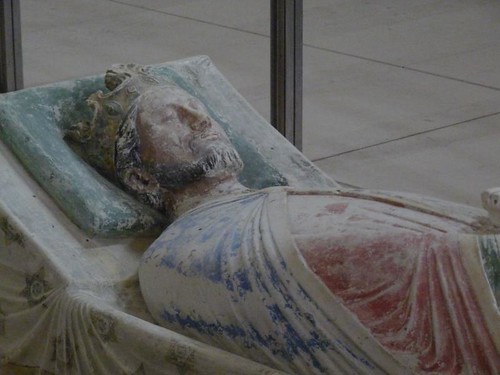Blogging since 2003 (apart from two years when I had nothing to say!)
Saturday, March 02, 2013
They come along like buses
Typical, you wait decades for news of a King and then two come along in relatively quick succession. Hot on the heels, or tyre tracks, of Richard III's cunning plan to avoid paying an extra charge at his local car park by burying himself under it, surely the ultimate in local tax avoidance, comes the news that Richard I was part of a nascent home improvement industry back in 12th century.
Scientists have discovered that the 'Lionhearts' heart was was preserved with mercury and tar before being "sweetened" with herbs to make it smell nice after his death, researchers have found. They found that embalmers preparing him for burial after death had used mercury and tar-like creosote to preserve the heart which had then been daubed with frankincense, myrtle, daisy and mint to make it smell sweet, before it was wrapped in linen and placed in a lead-lined box.
Richard I heart and his body were buried separately, this wasn't unusual in the middle ages or even later for that matter, I can think of two instances fairly local to us where a heart has been buried in one place and the body in another. Richard was killed during the siege of Chalus and his heart was subsequently buried in Rouen Cathedral, his body was buried at Fontevraud Abbey in the western Loire Valley, and his entrails interred in Chalus.
Fontrevaud Abbey
Fontrevaud Abbey is a great place to spend a day, we visited it back in 1990 when it seemed that French builders were still in the process of completing the building work. I have several photographs of the cloisters which were an oasis of cool on a very hot day.
Tomb of Richard I
Of course the recent revelations about Richard I and Richard III does make you wonder whether or not scientific methods will ever be applied to solve the long time mysteries of Perkin Warbeck and Lambert Simnel



By amazing coincidence today I was reading and writing about the other Richard, he of the Peasant's Revolt etc. Richard II's death was also shrouded in some sort of mystery as stories have always remained that he didn't die where and when they said.
ReplyDeleteYes, Richard II death is the original conspiracy theory isn't it (well after that bloke whose body vanished from his tomb behind a big rock somewhere in the middle east)? I mean how many people would have turned up at the public display of his dead body knowing what he looked like?
ReplyDeletenorth face, nike air max uk, sac hermes, hollister uk, nike air force, louboutin pas cher, michael kors, oakley pas cher, converse pas cher, abercrombie and fitch uk, hollister pas cher, nike free run, jordan pas cher, nike tn, burberry pas cher, longchamp pas cher, timberland pas cher, nike air max, polo ralph lauren, nike roshe, lululemon canada, ralph lauren uk, true religion outlet, guess pas cher, vans pas cher, sac longchamp pas cher, nike air max uk, true religion jeans, hogan outlet, north face uk, new balance, air max, ray ban pas cher, nike free uk, true religion outlet, nike blazer pas cher, sac vanessa bruno, michael kors pas cher, ray ban uk, polo lacoste, michael kors outlet, mulberry uk
ReplyDeletehollister clothing, giuseppe zanotti outlet, lululemon, wedding dresses, abercrombie and fitch, hermes belt, asics running shoes, bottega veneta, celine handbags, soccer shoes, valentino shoes, ferragamo shoes, vans outlet, mcm handbags, timberland boots, nike roshe run uk, longchamp uk, nike air max, north face outlet, p90x workout, new balance shoes, insanity workout, iphone 6 cases, herve leger, instyler, oakley, hollister, nike huaraches, soccer jerseys, nike trainers uk, babyliss, chi flat iron, ghd hair, baseball bats, jimmy choo outlet, mont blanc pens, north face outlet, mac cosmetics, beats by dre, nfl jerseys, reebok outlet, nike roshe run
ReplyDeleteralph lauren, vans, gucci, pandora jewelry, ray ban, hollister, ugg, swarovski crystal, links of london, lancel, toms shoes, juicy couture outlet, montre pas cher, pandora uk, replica watches, converse outlet, ugg,ugg australia,ugg italia, coach outlet, ugg uk, hollister, ugg pas cher, uggs outlet, ugg boots, supra shoes, pandora charms, marc jacobs, louboutin, thomas sabo, juicy couture outlet, ugg boots, karen millen uk, uggs outlet, converse, swarovski, uggs on sale, nike air max, ugg,uggs,uggs canada, wedding dresses
ReplyDeletemichael kors outlet store, coach purses, prada outlet, nike air max, michael kors outlet online, chanel handbags, ray ban sunglasses, longchamp outlet, coach outlet, replica watches, tiffany and co, oakley sunglasses wholesale, longchamp outlet, christian louboutin uk, michael kors outlet online, kate spade outlet, burberry handbags, ray ban sunglasses, coach outlet, tiffany jewelry, oakley sunglasses, nike free, nike air max, christian louboutin, kate spade, nike outlet, christian louboutin outlet, christian louboutin shoes, oakley sunglasses, jordan shoes, polo outlet, burberry outlet, polo ralph lauren outlet online, tory burch outlet, michael kors outlet, longchamp outlet, michael kors outlet, true religion outlet, gucci handbags, coach outlet store online, prada handbags, michael kors outlet online
ReplyDelete